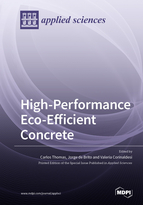High-Performance Eco-Efficient Concrete
A special issue of Applied Sciences (ISSN 2076-3417). This special issue belongs to the section "Materials Science and Engineering".
Deadline for manuscript submissions: closed (7 November 2020) | Viewed by 48553
Related Special Issue: Advances in High-Performance of Eco-Efficient Concrete
Special Issue Editors
Interests: cementitious materials; concrete technology; recycled aggregates concrete; durability; sustainable concrete
Special Issues, Collections and Topics in MDPI journals
Interests: CIB—International Council for Research and Innovation in Building and Construction; durability of building elements, maintenance of buildings; rehabilitation of buildings; building life cycle assessment
Special Issues, Collections and Topics in MDPI journals
Interests: eco-efficient concrete; fiber-reinforced concrete; recycled aggregate concrete; sustainability in concrete; ultra-high-performance concrete
Special Issues, Collections and Topics in MDPI journals
Special Issue Information
Dear Colleagues,
The benefits of recycling in the construction sector have been widely demonstrated and are unquestionable. The use of recycled aggregates, steel slags, and low-impact cements implies an important reduction of the environmental footprint, and eco-efficient concretes made with them must be a priority. However, these materials show in some cases losses of mechanical and durability behavior compared with natural materials. That is why we must invest our efforts on finding high-performance eco-efficient concretes that can compete or even surpass traditional concrete. To achieve this, research on them and dissemination of its results is essential. The objective of this Special Issue is to group the most recent and relevant research in relation to high-performance eco-efficient concrete into a single document. Subsequently, the possibility of publishing a book with the contributions of all authors will be assessed.
This Special Issue is therefore dedicated to “High-Performance Eco-Efficient Concrete”, and it intends to welcome contributions on, but not limited to, the following subjects:
- High-performance eco-efficient concrete using recycled aggregates
- High-performance eco-efficient concrete using slags
- High-performance eco-efficient concrete using low-impact binders
- Mechanical behavior of high-performance eco-efficient concrete
- Durability of high-performance eco-efficient concrete
- Rheology of high-performance eco-efficient concrete
- Permeability of high-performance eco-efficient concrete
- Fatigue behavior of high-performance eco-efficient concrete
- Behavior of high-performance eco-efficient concrete in aggressive environments
- Structural design of high-performance eco-efficient concrete
- Life cycle assessment of high-performance eco-efficient concrete
Dr. Carlos Thomas
Prof. Dr. Jorge de Brito
Dr. Valeria Corinaldesi
Guest Editors
Manuscript Submission Information
Manuscripts should be submitted online at www.mdpi.com by registering and logging in to this website. Once you are registered, click here to go to the submission form. Manuscripts can be submitted until the deadline. All submissions that pass pre-check are peer-reviewed. Accepted papers will be published continuously in the journal (as soon as accepted) and will be listed together on the special issue website. Research articles, review articles as well as short communications are invited. For planned papers, a title and short abstract (about 100 words) can be sent to the Editorial Office for announcement on this website.
Submitted manuscripts should not have been published previously, nor be under consideration for publication elsewhere (except conference proceedings papers). All manuscripts are thoroughly refereed through a single-blind peer-review process. A guide for authors and other relevant information for submission of manuscripts is available on the Instructions for Authors page. Applied Sciences is an international peer-reviewed open access semimonthly journal published by MDPI.
Please visit the Instructions for Authors page before submitting a manuscript. The Article Processing Charge (APC) for publication in this open access journal is 2400 CHF (Swiss Francs). Submitted papers should be well formatted and use good English. Authors may use MDPI's English editing service prior to publication or during author revisions.
Keywords
- High-performance;
- Eco-efficient concrete;
- Recycled aggregates;
- Slags;
- Low impact binders;
- Technical performance;
- Environmental performance;
- Costs
Related Special Issue
- Advances in High-Performance of Eco-Efficient Concrete in Applied Sciences (14 articles)








